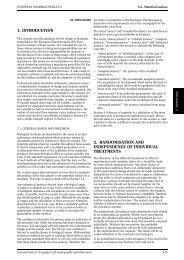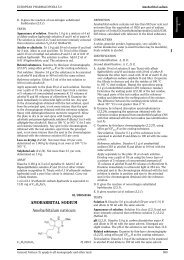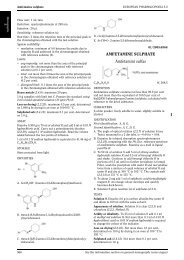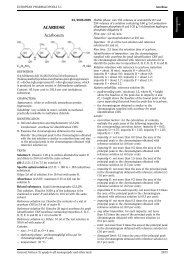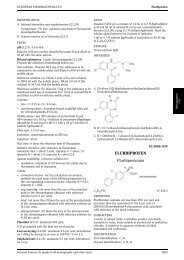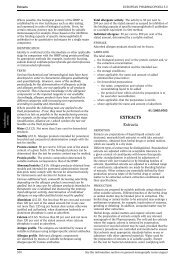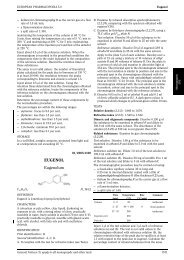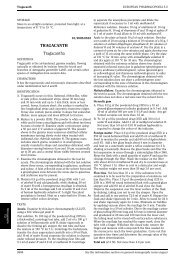OXYTOCIN Oxytocinum
OXYTOCIN Oxytocinum
OXYTOCIN Oxytocinum
You also want an ePaper? Increase the reach of your titles
YUMPU automatically turns print PDFs into web optimized ePapers that Google loves.
Oxytocin EUROPEAN PHARMACOPOEIA 5.0<br />
Injection: test solution and reference solution (a).<br />
Calculate the percentage content of C 22<br />
H 25<br />
ClN 2<br />
O 9<br />
taking<br />
1 mg of oxytetracycline as equivalent to 1.079 mg of<br />
oxytetracycline hydrochloride.<br />
STORAGE<br />
In an airtight container, protected from light. If the<br />
substance is sterile, store in a sterile, airtight, tamper-proof<br />
container.<br />
LABELLING<br />
The label states, where applicable, that the substance is free<br />
from bacterial endotoxins.<br />
IMPURITIES<br />
A. R1 = NH 2<br />
,R2=N(CH 3<br />
) 2<br />
,R3=R4=H,R5=OH:<br />
(4R,4aR,5S,5aR,6S,12aS)-4-(dimethylamino)-3,5,6,10,12,<br />
12a-hexahydroxy-6-methyl-1,11-dioxo-1,4,4a,5,5a,6,11,12aoctahydrotetracene-2-carboxamide<br />
(4-epioxytetracycline),<br />
B.R1=NH 2<br />
,R2=R4=R5=H,R3=N(CH 3<br />
) 2<br />
: tetracycline,<br />
C. R1 = CH 3<br />
,R2=R4=H,R3=N(CH 3<br />
) 2<br />
,R5=OH:<br />
(4S,4aR,5S,5aR,6S,12aS)-2-acetyl-4-(dimethylamino)-<br />
3,5,6,10,12,12a-hexahydroxy-6-methyl-4a,5a,<br />
6,12a-tetrahydrotetracene-1,11(4H,5H)-dione<br />
(2-acetyl-2-decarbamoyloxytetracycline),<br />
D. R = OH, R′ =H:(3S,4S,5S)-4-[(1R)-4,5-dihydroxy-9-<br />
methyl-3-oxo-1,3-dihydronaphtho[2,3-c]furan-1-yl]-<br />
3-(dimethylamino)-2,5-dihydroxy-6-oxocyclohex-1-<br />
enecarboxamide (α-apo-oxytetracycline),<br />
E. R = H, R′ =OH:(3S,4S,5R)-4-[(1R)-4,5-dihydroxy-9-<br />
methyl-3-oxo-1,3-dihydronaphtho[2,3-c]furan-1-yl]-<br />
3-(dimethylamino)-2,5-dihydroxy-6-oxocyclohex-1-<br />
enecarboxamide (β-apo-oxytetracycline),<br />
F. (4S,4aR,5R,12aS)-4-(dimethylamino)-3,5,10,11,<br />
12a-pentahydroxy-6-methyl-1,12-dioxo-1,4,4a,<br />
5,12,12a-hexahydrotetracene-2-carboxamide<br />
(anhydro-oxytetracycline).<br />
<strong>OXYTOCIN</strong><br />
<strong>Oxytocinum</strong><br />
01/2005:0780<br />
C 43<br />
H 66<br />
N 12<br />
O 12<br />
S 2<br />
M r<br />
1007<br />
DEFINITION<br />
Oxytocin is a cyclic nonapeptide having the structure of the<br />
hormone produced by the posterior lobe of the pituitary<br />
gland that stimulates contraction of the uterus and milk<br />
ejection in receptive mammals. It is obtained by chemical<br />
synthesis and is available in the freeze-dried form as an<br />
acetate. It contains not less than 93.0 per cent and not<br />
more than the equivalent of 102.0 per cent of the peptide<br />
C 43<br />
H 66<br />
N 12<br />
O 12<br />
S 2<br />
, calculated with reference to the anhydrous,<br />
acetic acid-free substance.<br />
By convention, for the purpose of labelling oxytocin<br />
preparations, 1 mg of oxytocin peptide (C 43<br />
H 66<br />
N 12<br />
O 12<br />
S 2<br />
)is<br />
equivalent to 600 IU of biological activity.<br />
CHARACTERS<br />
A white or almost white powder, hygroscopic, very soluble in<br />
water and in dilute solutions of acetic acid and of ethanol.<br />
IDENTIFICATION<br />
Examine the chromatograms obtained in the assay. The<br />
retention time of the principal peak in the chromatogram<br />
obtained with the test solution is approximately the same<br />
as that of the principal peak in the chromatogram obtained<br />
with the reference solution.<br />
TESTS<br />
pH (2.2.3). Dissolve 0.200 g in carbon dioxide-free water R<br />
and dilute to 10.0 ml with the same solvent. The pH of the<br />
solution is 3.0 to 6.0.<br />
Amino acids. Examine by means of an amino-acid analyser.<br />
Standardise the apparatus with a mixture containing<br />
equimolar amounts of ammonia, glycine and the L-form of<br />
the following amino acids:<br />
lysine threonine alanine leucine<br />
histidine serine valine tyrosine<br />
arginine glutamic acid methionine phenylalanine<br />
aspartic acid proline isoleucine<br />
together with half the equimolar amount of L-cystine. For the<br />
validation of the method, an appropriate internal standard,<br />
such as DL-norleucine R, isused.<br />
Test solution. Place 1.0 mg of the substance to be examined<br />
in a rigorously cleaned hard-glass tube 100 mm long and<br />
6 mm in internal diameter. Add a suitable amount of a<br />
50 per cent V/V solution of hydrochloric acid R. Immerse<br />
thetubeinafreezingmixtureat−5 °C, reduce the pressure<br />
to below 133 Pa and seal. Heat at 110 °C to 115 °C for 16 h.<br />
Cool, open the tube, transfer the contents to a 10 ml flask<br />
with the aid of five quantities, each of 0.2 ml, of water R and<br />
evaporate to dryness over potassium hydroxide R under<br />
reduced pressure. Take up the residue in water R and<br />
evaporate to dryness over potassium hydroxide R under<br />
reduced pressure; repeat these operations once. Take up<br />
the residue in a buffer solution suitable for the amino-acid<br />
analyser used and dilute to a suitable volume with the same<br />
buffer solution. Apply a suitable volume to the amino-acid<br />
analyser.<br />
2174 See the information section on general monographs (cover pages)
EUROPEAN PHARMACOPOEIA 5.0<br />
Oxytocin bulk solution<br />
Express the content of each amino acid in moles. Calculate<br />
the relative proportions of the amino acids, taking one-sixth<br />
of the sum of the number of moles of aspartic acid, glutamic<br />
acid, proline, glycine, isoleucine and leucine as equal to one.<br />
The values fall within the following limits: aspartic acid 0.95<br />
to 1.05; glutamic acid 0.95 to 1.05; proline 0.95 to 1.05;<br />
glycine 0.95 to 1.05; leucine 0.90 to 1.10; isoleucine 0.90 to<br />
1.10; tyrosine 0.7 to 1.05; half-cystine 1.4 to 2.1; not more<br />
than traces of other amino acids are present.<br />
Related peptides. Examinebyliquidchromatography<br />
(2.2.29) as described under Assay.<br />
Inject 50 µl of the test solution. In the chromatogram<br />
obtainedtheareaofanypeak,apartfromtheprincipal<br />
peak, is not greater than 1.5 per cent of the total area of the<br />
peaks; the sum of the areas of all the peaks, apart from the<br />
principal peak, is not greater than 5 per cent of the total<br />
area of the peaks. Disregard any peak due to the solvent<br />
and any peak with an area less than 0.1 per cent of that of<br />
the principal peak.<br />
Acetic acid (2.5.34): 6.0 per cent to 10.0 per cent.<br />
Test solution. Dissolve15.0mgofthesubstancetobe<br />
examined in a mixture of 5 volumes of mobile phase B and<br />
95 volumes of mobile phase A and dilute to 10.0 ml with the<br />
same mixture of solvents.<br />
Water (2.5.12). Not more than 5.0 per cent, determined on<br />
at least 50 mg by the semi-micro determination of water.<br />
Bacterial endotoxins (2.6.14): less than 300 IU/mg, if<br />
intended for use in the manufacture of parenteral dosage<br />
forms without a further appropriate procedure for removal<br />
of bacterial endotoxins.<br />
ASSAY<br />
Examine by liquid chromatography (2.2.29).<br />
Test solution. Prepare a 0.25 mg/ml solution of the<br />
substance to be examined in a 15.6 g/l solution of sodium<br />
dihydrogen phosphate R.<br />
Reference solution. Dissolve the contents of a vial of<br />
oxytocin CRS in a 15.6 g/l solution of sodium dihydrogen<br />
phosphate R to obtain a concentration of 0.25 mg/ml.<br />
Resolution solution. Dissolve the contents of a vial of<br />
oxytocin/desmopressin validation mixture CRS in 500 µl<br />
of a 15.6 g/l solution of sodium dihydrogen phosphate R.<br />
The chromatographic procedure may be carried out using:<br />
— a stainless steel column 0.125 m long and 4.6 mm in<br />
internal diameter packed with octadecylsilyl silica gel for<br />
chromatography R (5 µm),<br />
— asmobilephaseataflowrateof1ml/min:<br />
Mobile phase A. A 15.6 g/l solution of sodium<br />
dihydrogen phosphate R,<br />
Mobile phase B. Mix 1 volume of acetonitrile for<br />
chromatography R with 1 volume of water R,<br />
Time<br />
(min)<br />
Mobile phase A<br />
(per cent V/V)<br />
Mobile phase B<br />
(per cent V/V)<br />
Comment<br />
0 - 30 70 → 40 30 → 60 linear gradient<br />
30 - 30.1 40 → 70 60 → 30 switch to initial eluent<br />
composition<br />
30.1 - 45 70 30 re-equilibration<br />
— as detector a spectrophotometer set at 220 nm.<br />
Equilibrate the column with amixtureof30volumesof<br />
mobile phase B and 70 volumes of mobile phase A.<br />
Inject 25 µl of the resolution solution. When the<br />
chromatograms are recorded in the prescribed conditions,<br />
the retention times are: oxytocin about 7.5 min and<br />
desmopressin about 10 min. The test is not valid unless the<br />
resolution between the peaks corresponding to desmopressin<br />
and oxytocin is at least 5.0.<br />
Inject 25 µl of the test solution and 25 µl of the reference<br />
solution.<br />
Calculate the content of oxytocin (C 43<br />
H 66<br />
N 12<br />
O 12<br />
S 2<br />
)fromthe<br />
peak areas in the chromatograms obtained with the test<br />
solutionandthereferencesolutionandthedeclaredcontent<br />
of C 43<br />
H 66<br />
N 12<br />
O 12<br />
S 2<br />
in oxytocin CRS.<br />
STORAGE<br />
Store in an airtight container, protected from light, at a<br />
temperature of 2 °C to 8 °C. If the substance is sterile, store<br />
in a sterile, airtight, tamper-proof container.<br />
LABELLING<br />
The label states:<br />
— the oxytocin peptide content (C 43<br />
H 66<br />
N 12<br />
O 12<br />
S 2<br />
),<br />
— where applicable, that the substance is free from bacterial<br />
endotoxins.<br />
01/2005:0779<br />
<strong>OXYTOCIN</strong> BULK SOLUTION<br />
Oxytocini solutio<br />
DEFINITION<br />
Oxytocin bulk solution is a solution of oxytocin, a cyclic<br />
nonapeptide having the structure of the hormone produced<br />
by the posterior lobe of the pituitary gland that stimulates<br />
contraction of the uterus and milk ejection in receptive<br />
mammals. It is obtained by chemical synthesis. It is available<br />
as a bulk solution with a stated concentration of not less<br />
than 0.25 mg of oxytocin per millilitre, in a solvent that<br />
may contain an appropriate antimicrobial preservative. It<br />
contains not less than 95.0 per cent and not more than<br />
105.0percentoftheamountofthepeptideC 43<br />
H 66<br />
N 12<br />
O 12<br />
S 2<br />
stated per millilitre.<br />
By convention, for the purpose of labelling oxytocin<br />
preparations, 1 mg of oxytocin peptide (C 43<br />
H 66<br />
N 12<br />
O 12<br />
S 2<br />
)is<br />
equivalent to 600 IU of biological activity.<br />
CHARACTERS<br />
A clear, colourless liquid.<br />
IDENTIFICATION<br />
Examine the chromatograms obtained under Assay. The<br />
retention time of the principal peak in the chromatogram<br />
obtained with the test solution is similar to that of the<br />
principal peak in the chromatogram obtained with the<br />
reference solution.<br />
TESTS<br />
pH (2.2.3).ThepHofthepreparationtobeexaminedis3.0<br />
to 5.0.<br />
Amino acids. Examine by means of an amino-acid analyser.<br />
Standardise the apparatus with a mixture containing<br />
equimolar amounts of ammonia, glycine and the L-form of<br />
the following amino acids:<br />
lysine threonine alanine leucine<br />
histidine serine valine tyrosine<br />
arginine glutamic acid methionine phenylalanine<br />
aspartic acid proline isoleucine<br />
GeneralNotices(1)applytoallmonographsandothertexts 2175



